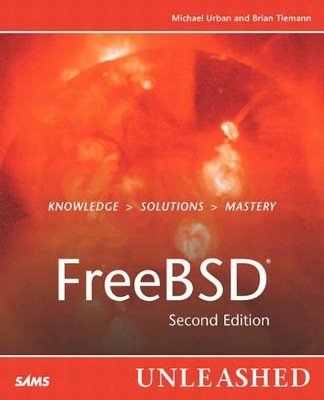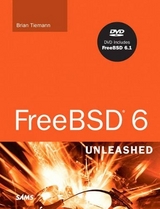
FreeBSD Unleashed
Sams Publishing
978-0-672-32456-7 (ISBN)
- Titel erscheint in neuer Auflage
- Artikel merken
Did you know that the special effects used in The Matrix were rendered using the FreeBSD system? Yahoo and the Internet Movie Database are also powered by FreeBSD. Now you can learn how to use FreeBSD to its full potential as well! FreeBSD Unleashed is a complete reference guide for FreeBSD administrators, developers, webmasters and database administrators and developers who want to learn more about this Unix-based, robust network. Once you've learned the tips and tricks included in FreeBSD Unleashed, you will be able to contribute your ideas to the FreeBSD open source project and help it grow!
Michael Urban is a biology student at the University of Minnesota. His current work on research projects involving African lions for the Lion Research Center includes programming projects with Java and C++. Michael has worked with various forms of Unix for several years, including FreeBSD, Linux, and Solaris. He has also worked as a technical analyst and is the author of Sams Teach Yourself FreeBSD in 24 Hours, also from Sams Publishing. In his free time, which is very sparse these days between exams and research projects, he enjoys reading and is also starting to pursue wildlife photography. Brian Tiemann has been a constant user of FreeBSD since his student days at Caltech, where he used it to build a movie fan Web site that continues to grow and sustain an ever-increasing load. Born in Ukiah, California, Brian has remained in the state all his life; he currently lives in San Jose and works in the networking appliance field. Aside from FreeBSD, his other interests include Macintoshes, motorcycles, and animation, topics about which he writes frequently.
Introduction.
I. INTRODUCTION TO FREEBSD.
1. What Is FreeBSD?
Why Use FreeBSD? What Can You Do with FreeBSD? A Brief History of FreeBSD and Unix. The Design Philosophy of Unix. How FreeBSD Compares to Other Operating Systems. FreeBSD Mascot.
2. Installing FreeBSD.
Checking Your Hardware. Creating Boot Disks. Booting into the Install Program. Navigating the Sysinstall Program. Creating Partitions and Assigning Mount Points. Selecting a Canned Distribution Set. Choosing the Installation Media. Post-installation Configuration and Customization. Exiting the Install Program and Rebooting the System. Booting FreeBSD for the First Time. Shutting Down FreeBSD.
3. Advanced Installation Issues.
Backing Up an Existing Windows or Linux Filesystem. Nondestructive Hard Disk Partitioning with FIPS. Working with FIPS. Potential Problems with and Limitations of Dual-Boot Systems. The FreeBSD Boot Manager. Booting FreeBSD from LILO. Alternate Installation Methods.
II. USING FREEBSD.
4. Your First Session with FreeBSD.
FreeBSD Startup Process. Logging In to FreeBSD. Logging Out of FreeBSD. Shutting Down the FreeBSD System.
5. Working with X-Windows.
The X-Server. Window Managers. The WindowMaker Window Manager. Working with Windows. WindowMaker Menus. Working with the Dock. Customizing WindowMaker. The Preferences Utility.
6. Working with Applications.
Working with Text. Creating Graphics and Editing Images with GIMP. Working with Multimedia. Networking Applications. Working with Java Applications.
7. Working with the Shell.
Introducing the Shell. Choosing a Shell for FreeBSD. Changing Your Shell. Getting Help in the Shell. Basic Shell File Manipulation. Text-Related Commands. Pipes and Input/Output Redirection. Command Completion and History Editing.
III. ADMINISTERING FREEBSD.
8. The FreeBSD Filesystem.
The FreeBSD Directory Structure. Monitoring Filesystem Usage. Mounting and Unmounting FreeBSD Filesystems. Mounting and Unmounting Filesystems from Other Operating Systems. Mounting and Unmounting CD-ROM and Floppy-Based Filesystems. Understanding the /etc/fstab File. Checking and Repairing Filesystems with fsck. Setting and Enforcing User Filesystem Quotas.
9. Users, Groups, and Permissions.
Introduction to Users and Groups. Why Use Groups? File Ownership. File and Directory Permissions. Access Control Lists (ACLs). Adding and Removing Users.
10. System Configuration and Startup Scripts.
Understanding the FreeBSD Startup Process. Resource Configuration Scripts. The inetd Daemon and the inetd.conf Configuration File. The System Logger (syslogd) and the syslog.conf File. Notes on the /etc/rc.local File.
11. Customizing the Shell.
What Is a Shell? Adding Shells to the System and Making Them Available. Using Alternate Shells. Shell Initialization Files. Customizing Your Shell Environment. Shell and Environment Variables.
12. Shell Programming.
Why Shell Programming Matters to You. A Simple Shell Program. Variables. Interacting with the User. Arithmetic in Shell Programs. Loops. Conditional Statements. Exit Status. Functions. File Descriptors.Debugging Shell Scripts. Advanced Features of Korn Shell Scripting.
13. Performance Monitoring, Process Control, and Job Automation.
Performance Monitoring with top. Process Monitoring with ps. Terminating Misbehaving Processes. Making Processes “Nice”. Automating Processes with the cron Daemon Scheduler. Creating Jobs to Run One Scheduled Time with the at Command. Controlling Access to the cron and at Commands. Using the Periodic Task Scheduler.
14. Installing Additional Software.
Introduction to Packages. Installing Packages. Removing Packages. Introduction to Ports. Installing and Removing Ports. Upgrading a Port. Updating and Maintaining Your Ports. Fresh Ports.
15. Printing.
How lpd, the Print Spooler, and the Print Queue Function in FreeBSD. Kernel, Device, and Communications Mode Configuration. Creating the Spool Directory and Setting Its Permissions. Setting Up Text and Conversion Filters. Configuring /etc/printcap to Control Print System Functions. Enabling lpd for Command-Line Printing. Basic Command-Line Printing. Printing from X-Windows. Printing in StarOffice. Using the lpq Command to Check the Status of Print Jobs. Removing Jobs from the Queue with the lprm Command. Controlling Printers. Basic Network Printing. Troubleshooting.
16. Kernel Configuration.
The Role of the Kernel. Why Configure a Custom Kernel? The Kernel Configuration Files. Creating a Custom Kernel Configuration File. Compiling and Installing the Custom Kernel. Adding Device Nodes to the /dev Directory (If Necessary). Recovering When Something Goes Wrong.
17. Keeping Up to Date with FreeBSD.
Tracking the FreeBSD Sources. Upgrading with make world. Things to Consider Before Choosing a make world Upgrade. Premake world Tasks. Rebuilding Your System from Sources. Using mergemaster to Check for Changed Configuration Files. Rebooting After the Upgrade.
18. Understanding Hard Disks and Filesystems.
IDE/ATA Access Modes. SCSI Disks. Understanding Hard Disk Geometry. Partitioning a Hard Disk. Creating the Disk Labels. Making the Filesystem Available for Use.
19. FreeBSD Survival Guide.
Migrating to FreeBSD. Dos and Donts (Common Gotchas). Performance Tuning. Preparing for the Worst: Backups and Mirrors.
20. Introduction to Perl Programming.
Perl in FreeBSD. Fundamentals of Perl Scripting. A Simple Perl Script. Advanced Perl Techniques. Useful Perl Resources.
IV. FREEBSD NETWORKING.
21. Networking with FreeBSD.
Introduction to Networking. Network Topologies. Network Components. Network Protocols. TCP/IP. IP Addresses. Routing. Hostnames and Domain Names. The Dynamic Host Configuration Protocol (DHCP) and Automatic IP Addressing.
22. Configuring Basic Networking Services.
Configuring the Network Card. Configuring Network Settings with sysinstall. Configuring Network Settings Without sysinstall. Creating IP Aliases. Mapping Names to IP Addresses with the /etc/hosts File. Testing Network Connectivity with ping. Configuring DNS with the /etc/resolv.conf File. A Look at Other Network Configuration Files.
23. Connecting to the Internet with PPP.
Choosing an ISP. Gathering Needed Information. User PPP Versus Kernel PPP. Configuring Kernel PPP. Configuring User PPP. PPP Over Ethernet (PPPoE). Troubleshooting PPP. Finding Information for Advanced Configurations.
24. Configuring E-mail Services.
Introduction to SMTP. Mail Transfer Agents (MTAs) and Mail User Agents (MUAs). Configuring Basic E-mail Services with Sendmail. Understanding Relaying. Introduction to POP3. Configuring a POP3 Server with Qpopper. Configuring an IMAP Server with IMAP-UW. E-mail for Standalone Workstations. A Look at Some Sendmail Replacements.
25. Configuring a Web Server.
Introduction to the HTTP Protocol. Obtaining and Installing Apache. Apache File Layout. Configuring Apache. Starting and Stopping the HTTP Daemon. Basic Access Control with Apache. Virtual Hosting. Introduction to Apache Modules. Server-Side Includes. Introduction to CGI.
26. Configuring an FTP Server.
Introduction to the File Transfer Protocol. Overview of the FTP Directory Structure. Configuring the FTP Server. Controlling FTP Access. Allowing Anonymous FTP Access. Virtual Hosting. Using Alternate FTP Servers.
27. Configuring an Internet Gateway.
The Basics of Routers and Network Address Translation (NAT) in FreeBSD. Configuring a NAT Gateway in FreeBSD. Enabling NAT for Systems Without Static IP Addresses. Configuring Clients to Use the New Gateway. Configuring Wireless Internet Access. Routing Between Three or More Networks. Dynamic Routing.
28. Configuring a Database Server.
Introduction to Database Design and Administration. SQL: Structured Query Language. Using the MySQL and PostgreSQL Open-Source Databases. Constructing a Database System. Writing Administration Scripts. Connecting a Database to the Web. Using PHP to Provide Database-Driven Content to Web Pages. Optimizing Database Performance. Performing Database System Backups.
29. Network Security.
Choosing a Security Model Based on Your Security Risks. Security Models. The Security Risks You Face. Password Policies. Avoiding Problems with Clear-Text Services. Securing Terminal Traffic (SSH). Securing E-mail Services (POP3 and IMAP). Securing FTP. Securing Apache. System Security Profiles and Kernel Security (securelevel). Using a Firewall. Preventing Intrusions and Compromises. Denial of Service (DOS) Attacks. Physical Security. Other Security Resources.
30. Virtual Private Networks (VPNs).
What Is a VPN? VPN Topologies. VPN Services in FreeBSD: IPSec. FreeBSD as a VPN Server.
31. The Domain Name Server.
Introduction to DNS Structure, Functions, and Software. Enabling the Name Server Daemon. Working with the BIND Configuration File (named.conf). Creating a Zone File. Configuring a Caching Name Server.
32. The Network Filesystem (NFS).
Introduction to NFS. Configuring an NFS Server. Configuring an NFS Client. Auto-Mount Daemon (amd).
33. File and Print Sharing with Microsoft Windows.
SMB/CIFS and Samba. Installing and Configuring Samba. Other Samba Components. Future Samba Development. Accessing Shared Files on a Windows System (the smbfs Filesystem).
34. Dynamic Host Configuration Protocol (DHCP).
How DHCP Works. Advantages of DHCP over Static IP Addresses. Kernel Configuration for DHCP. Enabling DHCP. The dhclient Program. DHCP Server Daemon. Configuring the dhcpd Configuration File.
V. X-WINDOWS.
35. Advanced X-Windows Configuration.
Configuring X-Windows with the xf86config Script. Understanding the XF86Config File. Testing the X-Windows Setup. Your Personal .xinitrc File. Working with Fonts. Using Remote X-Windows Clients. Using the xdm Graphical Login Manager.
VI. APPENDIXES.
Appendix A. Command Reference and Configuration File Reference.
Command Switches and Options.
Appendix B. Hardware Compatibility Lists.
System Requirements. Supported Hardware. Video Cards Supported by X-Windows.
Appendix C. Troubleshooting Installation and Boot Problems.
Installation Problems. Boot Problems and Other Non-installation Problems.
Appendix D. Sources for More Information.
FreeBSD-Specific Resources. Other BSD-Related Resources. Other Internet Resources.
Index.
| Erscheint lt. Verlag | 6.5.2003 |
|---|---|
| Verlagsort | Indianapolis |
| Sprache | englisch |
| Maße | 188 x 231 mm |
| Gewicht | 1615 g |
| Themenwelt | Informatik ► Betriebssysteme / Server ► Unix / Linux |
| ISBN-10 | 0-672-32456-3 / 0672324563 |
| ISBN-13 | 978-0-672-32456-7 / 9780672324567 |
| Zustand | Neuware |
| Haben Sie eine Frage zum Produkt? |
